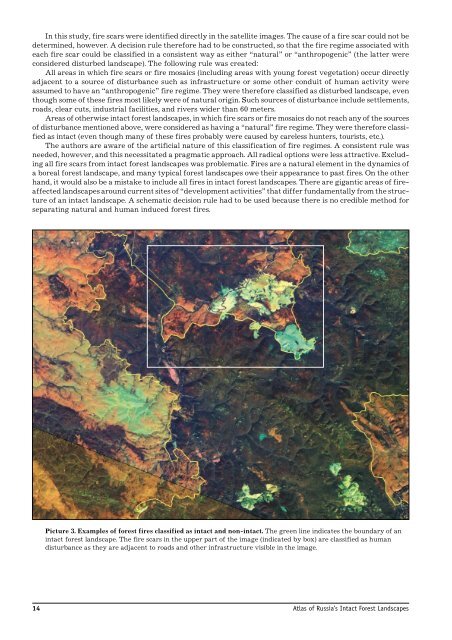Atlas of Russia's Intact Forest Landscapes - World Resources Institute
Atlas of Russia's Intact Forest Landscapes - World Resources Institute
Atlas of Russia's Intact Forest Landscapes - World Resources Institute
You also want an ePaper? Increase the reach of your titles
YUMPU automatically turns print PDFs into web optimized ePapers that Google loves.
In this study, fire scars were identified directly in the satellite images. The cause <strong>of</strong> a fire scar could not be<br />
determined, however. A decision rule therefore had to be constructed, so that the fire regime associated with<br />
each fire scar could be classified in a consistent way as either “natural” or “anthropogenic” (the latter were<br />
considered disturbed landscape). The following rule was created:<br />
All areas in which fire scars or fire mosaics (including areas with young forest vegetation) occur directly<br />
adjacent to a source <strong>of</strong> disturbance such as infrastructure or some other conduit <strong>of</strong> human activity were<br />
assumed to have an “anthropogenic” fire regime. They were therefore classified as disturbed landscape, even<br />
though some <strong>of</strong> these fires most likely were <strong>of</strong> natural origin. Such sources <strong>of</strong> disturbance include settlements,<br />
roads, clear cuts, industrial facilities, and rivers wider than 60 meters.<br />
Areas <strong>of</strong> otherwise intact forest landscapes, in which fire scars or fire mosaics do not reach any <strong>of</strong> the sources<br />
<strong>of</strong> disturbance mentioned above, were considered as having a “natural” fire regime. They were therefore classified<br />
as intact (even though many <strong>of</strong> these fires probably were caused by careless hunters, tourists, etc.).<br />
The authors are aware <strong>of</strong> the artificial nature <strong>of</strong> this classification <strong>of</strong> fire regimes. A consistent rule was<br />
needed, however, and this necessitated a pragmatic approach. All radical options were less attractive. Excluding<br />
all fire scars from intact forest landscapes was problematic. Fires are a natural element in the dynamics <strong>of</strong><br />
a boreal forest landscape, and many typical forest landscapes owe their appearance to past fires. On the other<br />
hand, it would also be a mistake to include all fires in intact forest landscapes. There are gigantic areas <strong>of</strong> fireaffected<br />
landscapes around current sites <strong>of</strong> “development activities” that differ fundamentally from the structure<br />
<strong>of</strong> an intact landscape. A schematic decision rule had to be used because there is no credible method for<br />
separating natural and human induced forest fires.<br />
Picture 3. Examples <strong>of</strong> forest fires classified as intact and non-intact. The green line indicates the boundary <strong>of</strong> an<br />
intact forest landscape. The fire scars in the upper part <strong>of</strong> the image (indicated by box) are classified as human<br />
disturbance as they are adjacent to roads and other infrastructure visible in the image.<br />
14 <strong>Atlas</strong> <strong>of</strong> Russia’s <strong>Intact</strong> <strong>Forest</strong> <strong>Landscapes</strong>

















